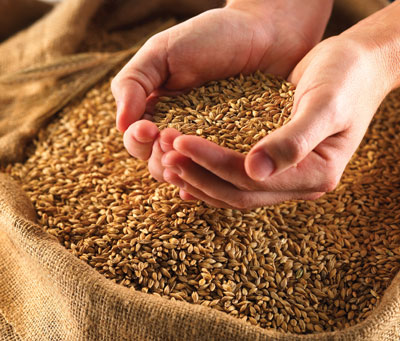
Confused between whole wheat and whole grain? The two are not one and the same, although it’s a common misconception. You may have clients, such as schools, asking you for new nutritional requirements in your crust.
Confused between whole wheat and whole grain? The two are not one and
the same, although it’s a common misconception. You may have clients,
such as schools, asking you for new nutritional requirements in your
crust.

|
| Do you know the difference between whole wheat and whole grain flours?
|
“Whole grains are here to stay,” says Kevin Jones, technical services
manager for Horizon Milling. “And it is mostly driven by the schools.”
Many of the inquiries Jones fields from pizza makers involve an
interest in creating a whole-wheat crust to fulfil the new mandates and
interests of school boards, he says. When he learns that is the case,
Jones says he generally asks question to clarify and learns that what
pizza makers actually are required to develop is a whole-grain pizza
crust. Whole-wheat and whole-grain are easy to confuse but they do not
mean the same thing.
WHOLE GRAINS
Grains are the seeds of plants such as wheat and rice. The seeds are
composed of three parts – the bran, the endosperm and the germ – all of
which play a nutritional role. These grains can be whole or refined.
Whole grains have all their parts whereas refined grains have had the
germ and bran removed. Manufacturers in Canada are required to enrich
white flour to put back nutrients lost in processing, but this still
does not equate to the fibre and completeness of whole grains.
The Health Canada website tells us that when wheat is milled to make
flour in Canada, the parts of the grain are usually separated and then
recombined to make specific types of flour, such as whole-wheat,
whole-grain and all-purpose. To be considered whole-grain, all parts of
the kernel should be used in relatively the same proportions as in its
original state. However, food and drug regulations allow up to five per
cent of the kernel to be removed to help lengthen the shelf life of
whole-wheat flour. The section of the kernel that is detached for this
purpose contains a lot of the germ and some of the bran. If this part
of the kernel has been removed, the flour is no longer be considered
whole-grain.
Health Canada further notes: “Whole wheat bread is made with whole
wheat flour. As sold in Canada, whole wheat flour may have much of the
germ removed. Therefore, 100 per cent whole wheat bread may not be
whole grain – however, it remains a nutritious choice that provides
dietary fibre not found in white bread.”
So, while whole-wheat is a better fibre provider than white, it’s not
the same as whole-grain flour. Not only is it not the same
nutrition-wise, but there is a taste difference and other factors to
consider when formulating a whole-grain crust.
WORKING WITH WHOLE GRAINS
If you want to develop a whole-grain pizza crust, there’s no way to
avoid the many experiments in search of perfection, but that’s the fun
and creative part! There are, however, some things to keep in mind when
working with whole-grain flours, including how you want the finished
product to look and taste.
Bob Meyer, director of technical services for Dakota Specialty Milling
and member of the American Institute of Baking’s education committee,
says he has seen pizza makers experimenting with all extremes in the
last year. Some want the whole grains visible, some as hidden as
possible. It all depends on the clientele you’re serving.
The pieces in whole-grain flour will cut the structure of the gluten,
says Meyer. “If you’re adding flakes you would need to be careful of
tears in the pizza dough.”
You also need to start with good high-protein flour when doing a
multigrain blend, one that will carry the “dead weight” of the grains,
he adds. You may need to consider increasing yeast, gluten or other
dough strengtheners. Essentially, he recommends maximizing the strength
of the dough lest it fall apart.
Also, Meyer notes that you need to optimize hydration levels because the whole grains “act like little sponges.”
Taste is obviously of utmost consideration. If it doesn’t taste good,
it’s not going to sell. Jones notes that whole-wheat crusts tend to be
a less favourable taste-wise than whole-grain crusts, citing a more
positive reception to whole-grain pizza taste. Meyer explains that
since whole grains do have a much stronger flavour than white flour,
you may have the challenge of masking that with sugar and spices for
your particular clientele.
“The more wheat, the nuttier the taste,” says Meyer. “You may want to
look at using other sugars, like molasses or honey to complement it.”
You can source many different types of whole-grain flour blends; what
percentage of them you incorporate into the crust will depend on how
you want your crust to turn out. If you want to develop a rye or barley
crust, you will find unique challenges in working with the different
plants as they will not all formulate the same. For example, rye can be
difficult to work with for pizza in that rye grains tend to make the
dough very stiff and less pliable, says Jones. However, experimentation
can lead you to the right balance, depending on the kind of crust
you’re seeking.
While considering how to take away salt and fat in pizza, don’t forget
about health benefits that can be added. Whole grains are a great
source of fibre, a nutrient gaining traction in the national
conversation. A healthier crust can help you attain, maintain or grow
your key school business, as well as offer a healthier option for
everyone.
Print this page